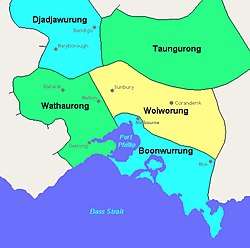Kulin

The Kulin nation is an alliance of five Indigenous Australian tribes in south central Victoria, Australia. Their collective territory extended around Port Phillip and Western Port, up into the Great Dividing Range and the Loddon and Goulburn River valleys.
Before British colonisation, the tribes spoke five related languages. These languages were spoken in two groups: the Eastern Kulin group of Woiwurrung, Boonwurrung, Taungurong and Ngurai-illam-wurrung; and the western language group of just Wathaurung.
The central Victoria area has been inhabited for an estimated 60,000 to 100,000 years before European settlement.[1] At the time of British settlement in the 1830s, the collective populations of the Woiwurrung, Boonwurrung and Wathaurong tribes of the Kulin nation was estimated to be under 20,000.[2][3] The Kulin lived by fishing, hunting and gathering, and made a sustainable living from the rich food sources of Port Phillip and the surrounding grasslands.[4]
Due to the upheaval and disturbances from British settlement from the 1830s on, there is limited physical evidence of the Kulin peoples' collective past. However, there is a small number of registered sites of cultural and spiritual significance in the Melbourne area.[5][6]
Nations
- Woiwurrung (Woy-wur-rung) – the Wurundjeri People
- 'Boonwurrung – the Boon wurrung People
- Wathaurrung (Wath-er-rung) – the Wathaurong People
- Daungwurrung (Tung-ger-rung) – the Taungurong People
- Dja DjaWrung (Jar-Jar wrung) – the Dja Dja Wurrung or Jaara People.
Diplomacy
| Wikisource has original text related to this article: |
When foreign people passed through or were invited onto tribal lands, the ceremony of Tanderrum – freedom of the bush – would be performed. This allowed safe passage and temporary access and use of land and resources by foreign people. It was a diplomatic rite involving the landholder's hospitality and a ritual exchange of gifts.
Notes
Citations
- ↑ Gary Presland, The First Residents of Melbourne's Western Region, (revised edition), Harriland Press, 1997. ISBN 0-646-33150-7. Presland says on page 1: "There is some evidence to show that people were living in the Maribyrnong River valley, near present day Keilor, about 40,000 years ago."
- ↑ Indigenous connections to the site.
- ↑ Gary Presland, Aboriginal Melbourne: The Lost Land of the Kulin People, Harriland Press (1985), Second edition 1994, In 1920 they all died ISBN 0-9577004-2-3. This book describes in some detail the archaeological evidence regarding aboriginal life, culture, food gathering and land management, particularly the period from the flooding of Bass Strait and Port Phillip from about 7–10,000 years ago, up to the European colonisation in the 19th century.
- ↑ Gary Presland, Aboriginal Melbourne: The Lost Land of the Kulin People, Harriland Press (1985), Second edition 1994, ISBN 0-9577004-2-3. This book describes in some detail the archeological evidence regarding aboriginal life, culture, food gathering and land management, particularly the period from the flooding of Bass strait and Port Phillip from about 7-10,000 years ago up to the European colonisation in the nineteenth century.
- ↑ Meyer Eidelson, The Melbourne Dreaming. A Guide to the Aboriginal Places of Melbourne, pp8-9, Aboriginal Studies Press, Canberra, 1997. Reprint 2000. ISBN 0-85575-306-4
- ↑ See also Meyer Eidelson, The Footballer, First in the league, in Walks in Port Phillip. A guide to the cultural landscapes of a City Archived 30 October 2008 at the Wayback Machine.. Retrieved 1 November 2008
Sources
- "Indigenous connections to the site" (PDF). Archived from the original (PDF) on 31 August 2007.
Bibliography
- People of the Merri Merri. The Wurundjeri in Colonial Days., by Isabel Ellender and Peter Christiansen. ISBN 0-9577728-0-7
- The First Residents of Melbourne's Western Region, by Gary Presland. ISBN 0-646-33150-7
- Wauthaurong Too Bloody Strong: Stories and life journeys of people from Wauthaurong, by Bruce Pascoe (ed.) (1997), Pascoe Publishing Pty Ltd, Apollo Bay, Victoria, Australia. ISBN 094708731-1